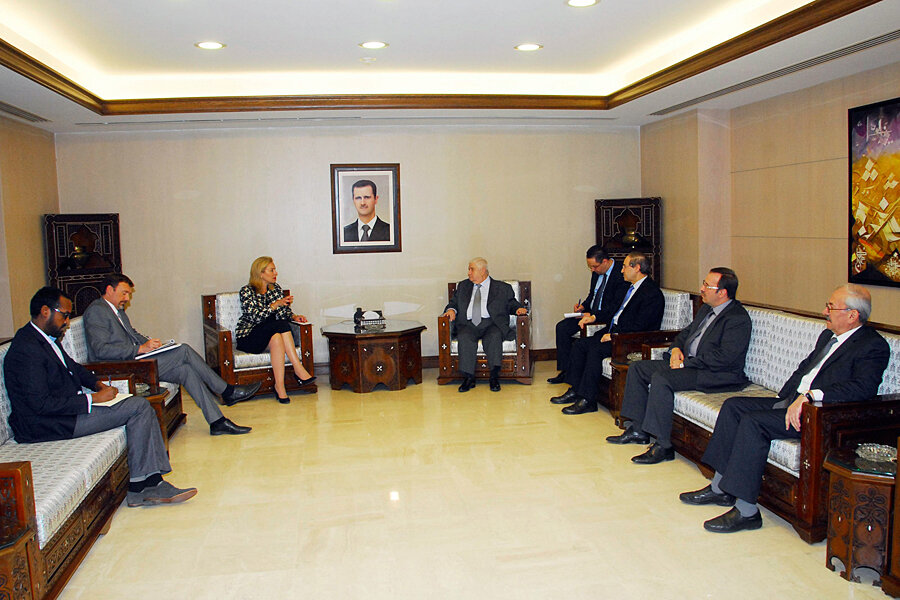Months of stalling preceded Syria's latest chemical weapons handover
Loading...
| Beirut, Lebanon
Amid mounting concern about Syrian foot-dragging in removing and destroying its chemical weapons, the international body overseeing the effort said today that Syria has accelerated its efforts to surrender its toxic arsenal.
According to the Organization for the Prohibition of Chemical Weapons, Syria is on track to hand over more than one-third of its chemical stockpile by the end of the week. Still, the process has fallen well behind schedule after making progress last fall. Under the agreement between the Syrian regime and the OPCW, the deadliest agents were supposed to be removed from Syria by Jan. 1 and the rest of the stockpile by Feb. 6. Syria has blamed the delay on the ongoing civil war.
"Given delays since the lapse of the two target dates for removal, it will be important to maintain this newly created momentum," Ahmed Uzumcu, OPCW's general director, told a session of the body's executive council. "For its part, the Syrian government has reaffirmed its commitment to implement the removal operations in a timely manner."
Western officials and some analysts have pushed back against Syria's explanation for the delay. They argue that the Assad regime is deliberately delaying implementation of the chemical weapons eradication program in order to buy time and win new concessions from the West. The slower pace has cast doubt on whether Syria can hit a Jun. 30 deadline for the destruction of its entire stockpile.
“[Syrian President] Bashar al-Assad knows his usefulness to the West and everyone else dramatically drops off when he surrenders those weapons,” says Andrew Tabler, a Syria expert with the Washington Institute for Near East Policy. “He’s trying to get extra concessions while continuing to shoot the Syrian people into submission.”
In an OPCW meeting on Feb. 21, Robert Mikulak, the US representative to the organization, said that the program had “seriously languished and stalled” and accused the Syrian government of putting “its energy into excuses, instead of actions."
US-Russian cooperation
Syria pledged to hand over its chemical arsenal last September in an agreement brokered by the US and Russia, which are currently at odds over Ukraine. The deal followed a chemical weapons attack on Damascus suburbs in August that left more than 1,000 people dead, sparking international outrage and US vows of a military response. The agreement led to the postponement of planned air strikes led by the US.
Syria’s 1,300 tons of chemical weapons include Sarin and VX nerve agents and mustard gas. Once the deal was struck, the toxic arsenal was swiftly cataloged and secured, prompting Secretary of State John Kerry to say in October that the Assad regime deserved “credit” for its cooperation.
But hopes that the program would continue apace faded in December, as the Jan. 1 deadline approached without the removal of the most toxic agents.
The Syrian authorities have blamed the delay on the security situation, bad weather, and a lack of protective equipment for the convoys carrying the chemical agents, such as armored jackets for shipping containers and detectors for improvised explosive devices. The OPCW says that Syria has received the necessary equipment, including the armored jackets.
The Netherlands-based organization said today that a consignment of mustard gas, a blistering agent, was transported to the port city of Latakia last week and a further "significant" consignment of lethal "Priority 1" chemicals will reach the city this week. That consignment would complete the transfer of more than 35 percent of all of Syria's estimated 1,300 tons of chemical weapons stockpile, including 23 percent of the deadliest Priority 1 chemicals and 63 percent of Priority 2 agents.
Scheduling conflicts
The convoys begin in the Damascus area, where the bulk of the chemical arsenal has been stockpiled, and follow the highway north to Homs, then west toward Tartous and finally north along the coast to the port at Latakia. The only potentially hazardous section of the route is the stretch north of Damascus, which passes through the mountainous Qalamoun area, where the Syrian Army is battling rebel forces.
However, the Army secured the highway area in early December and traffic has resumed in relative safety. Syrian rebels say they are not launching ambushes there, partly to avoid civilian casualties, but also because they say it is in their interest to see the chemical weapons arsenal removed from Syria.
Last month, the Assad regime offered a revised 100-day schedule that would remove the chemical arsenal in 31 separate convoys by May 31. But the US and Finnish companies contracted to destroy the stockpile doubt that would leave enough time to complete the task by the Jun. 30 deadline.
The OPCW rejected the Syrian proposal and instead offered a revised plan that set a Mar. 31 deadline, according to an OPCW progress report released last week. The Syrian authorities counter-proposed an April 27 deadline. Any change to the original agreement would have to be approved not only by the OPCW but also the UN Security Council, potentially leading to a further delay.
A similar deadlock has resulted over the destruction of Syria’s chemical weapons production facilities, which is scheduled to be completed by March 15. Syria says it will “inactivate” 12 of the 26 sites instead of “physically destroying” them, suggesting that the facilities could be restored to their former use with relative ease.





